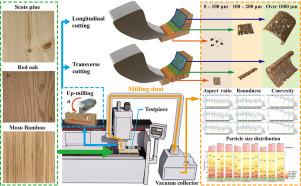切削方向和平均切屑厚度对木竹铣削粉尘形态特征的影响
IF 5.4
2区 工程技术
Q2 ENGINEERING, MANUFACTURING
CIRP Journal of Manufacturing Science and Technology
Pub Date : 2025-06-04
DOI:10.1016/j.cirpj.2025.04.012
引用次数: 0
摘要
粉尘暴露现在已成为一种重大危害,对工人健康和设备安全构成威胁。了解磨粉粉尘的特性,采取相应的措施来减少粉尘的排放是很重要的。本研究对苏格兰松、红橡树和毛竹三种生物质材料的磨粉粉尘进行了综合分析,重点研究了切削方向和平均切屑厚度对磨粉粉尘形态特征的影响。该研究使用筛分方法来研究不同平均薄片厚度的粒度分布。此外,利用平板扫描图像分析研究了颗粒尺寸特征(如面积等效直径和最小Feret直径)与各种形态参数(如长宽比、圆度和凹凸度)之间的相关性。本研究还利用光学显微镜观察了代表性颗粒的形貌。毛竹产生的可吸入粉尘比红橡树和苏格兰松多,而苏格兰松和红橡树产生的可吸入粉尘的面积当量直径和纵横比中值分别最低。磨粉粉具有较高的圆度和凹凸度。纵向切削和横向切削对大颗粒和细粉尘的切削效果不同。平均切屑厚度对圆度和凸度的影响较小。本研究揭示了切割方向与纤维方向夹角与不同粒径粉尘之间的关系,以及其对不同粒径颗粒长径比、圆度和凹凸度的具体影响。该研究为环境中木材、竹材等粉磨粉尘的清洁生产和健康保护提供了重要数据。本文章由计算机程序翻译,如有差异,请以英文原文为准。

Effects of cutting direction and average chip thicknesses on the wood and bamboo milling dust morphological characteristics
Dust exposure has now become a significant hazard, posing risks to both worker health and equipment safety. It is important to understand the characteristics of milling dust and take appropriate measures to reduce dust emissions. This study provides a comprehensive analysis of milling dust generated from three biomass materials–Scots pine, red oak and Moso bamboo, primarily focusing on the influence of cutting directions and average chip thickness on the morphological characteristics of dust from these materials. The research uses the sieving method to investigate particle size distribution across varying average chip thicknesses. Furthermore, flatbed scanning image analysis is utilized to investigate the correlations between particle size characteristics such as area-equivalent diameter and minimum Feret diameter, and various morphological parameters including aspect ratio, roundness, and convexity. The study also observes the morphology of representative particles using an optical microscope. It is found that Moso bamboo could produce more inhalable dust than red oak and Scots pine, while the lowest median area-equivalent diameter and aspect ratio are discovered in dust from Scots pine and red oak, respectively. Moso bamboo milling dust shows a higher roundness and convexity. Longitudinal and transverse cutting have different effects on large size particles and fine dust. A minor influence of average chip thickness on roundness and convexity is found. This study reveals the relationship between the angle between the cutting direction and the fiber direction and different sizes of dust, as well as its specific effects on the aspect ratio, roundness, and convexity of particles of different sizes. The study provides essential data for cleaner production and health protection of milling dust including wood and bamboo in the environment.
求助全文
通过发布文献求助,成功后即可免费获取论文全文。
去求助
来源期刊

CIRP Journal of Manufacturing Science and Technology
Engineering-Industrial and Manufacturing Engineering
CiteScore
9.10
自引率
6.20%
发文量
166
审稿时长
63 days
期刊介绍:
The CIRP Journal of Manufacturing Science and Technology (CIRP-JMST) publishes fundamental papers on manufacturing processes, production equipment and automation, product design, manufacturing systems and production organisations up to the level of the production networks, including all the related technical, human and economic factors. Preference is given to contributions describing research results whose feasibility has been demonstrated either in a laboratory or in the industrial praxis. Case studies and review papers on specific issues in manufacturing science and technology are equally encouraged.
 求助内容:
求助内容: 应助结果提醒方式:
应助结果提醒方式:


